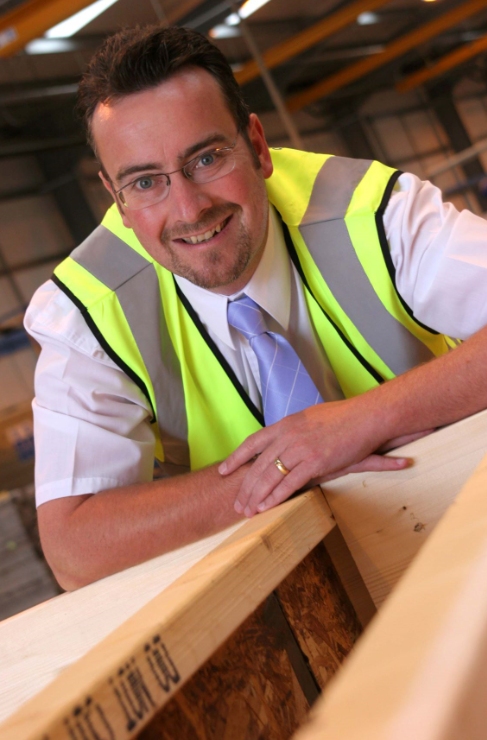
A project aimed at speeding up housing delivery with modern methods of construction (MMC) has found a way to build new homes that are wind- and water-tight within a day.
The three-year Advanced Industrialised Methods for the Construction of Homes (AIMCH) project, which started 18 months ago, is trialing a range of solutions that could build homes faster.
Working with some of the UK’s biggest housebuilders, the project compares new and old manufacturing methods on real building sites and the impact MMC can have on housebuilding.
AIMCH project director Stewart Dalgarno said he was “convinced” that MMC such as offsite panelised systems and digital working offer “unrivalled benefits”.
The project is collecting findings across different sub-studies: on-site monitoring, productivity, cost, and digital and industrial innovation. Some of this innovation includes augmented reality, offsite panelised systems, and roof trusses being lifted fully into place.
Six hour assembly time
The project found that homes can be erected in under six hours using panelised MMC offsite construction technology (Category 2 MMC as defined by the government), and findings from the first half of the project suggest that homes can be built “significantly faster” than using traditional methods.
The AIMCH MMC systems being trialed for mainstream uptake include pre-insulated wall systems, factory fitted windows, pre-loading materials and roofing systems that can be pre-tiled without the need for scaffolding or safety decking during the construction process.

Dalgarno added that optimising the crane to a single day ensures buildings can be progressed internally and externally immediately after the building envelope is completed. Delivery from foundation level to completion can take as little as eight to ten weeks, depending on house size and complexity, half the time of traditional masonry methods, according to the project’s findings.
AIMCH study findings also found a reduction in defects using modern methods of construction.
During the project, prototype panelised systems have been delivered to live builds. Several closed panel timber frame units were delivered on a live development near Warrington and Milton Keynes by AIMCH partners Barratt Developments and L&Q.
Barratt roofing first
On the Barratt development site, two of the units were also erected without any scaffold, as well as the roof being pre-tiled on the ground before being lifted into place – a first for Barratt as a company. All six homes are now complete, sold and being lived in.
Another AIMCH prototype build is progressing at L&Q’s Saxon Reach development in Milton Keynes, where all 225 properties on-site – ranging from one-bedroom apartments to five-bedroom homes – are being constructed using Stewart Milne Timber Frames’ offsite panelised systems. Several innovations are being trialled including pre-fabricated party wall system and a “fire-safe” closed panel solution for apartments.
Product testing is underway to validate the systems being trialled to ensure they meet all the requirements of future regulatory demands, such as energy, whole life cost, embodied carbon and building safety requirements.
Digital tech role
Digital technology is also playing a key role in the AIMCH project where automotive learning from around the world is being used to develop advanced manufacturing approaches, such as simulation, to build a model of the “future offsite factory”, where digital technology and automation such as robotics drives productivity.
It is also developing a guide to creating a BIM Housing Manual for developers, that will be specific to housing developments. Organisations will be able to use this manual to create a digital representation of the physical and functional characteristics of a building.
The guide is due to be trialled with partners towards the end of the 2020.
Stewart Dalgarno, AIMCH project director and Stewart Milne Group director of product development said: “These technological changes mean we also need a workforce equipped with the necessary skillset to support the transformation in housebuilding and construction industries.
“This brings the opportunity to attract new talent with digital, logistics, engineering, design, robotics, BIM, supply chain and project chain management skills, making the sector more appealing and creating a diverse workforce. These new smarter ways of working will help the industry to achieve more with less, the need for which has been highlighted even more this year as the industry adapts to working through ongoing covid-19 restrictions.
“It has been a challenging year for the sector, yet despite this, we are achieving fantastic outcomes. Much has been achieved since the AIMCH project started 18 months ago, and we are incredibly excited about the next part of the journey where we will be looking at creating a future factory model, design standardisation, studying productivity, commercial viability, embodied carbon, and implementing new technologies.”
Comments
Comments are closed.











“More haste, less speed” as the old saying goes eh..
How about focusing on QUALITY first? The current break neck speed shoddy and as we are now seeing, criminally negligent building methods sees homebuyers saddled with homes riddled with sometimes HUNDREDS of faults..and virtually no redress against the builders!
It’s time that houses were BUILT up – not thrown up!